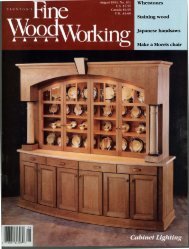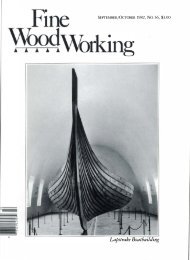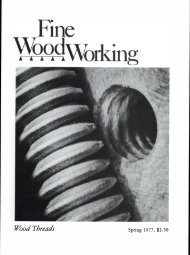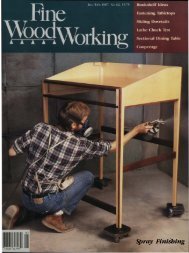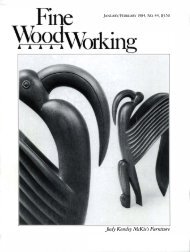NOVEMBER/DECEMBER 1983, No. 43, $3.50 Making ... - Wood Tools
NOVEMBER/DECEMBER 1983, No. 43, $3.50 Making ... - Wood Tools
NOVEMBER/DECEMBER 1983, No. 43, $3.50 Making ... - Wood Tools
You also want an ePaper? Increase the reach of your titles
YUMPU automatically turns print PDFs into web optimized ePapers that Google loves.
Applying Classical Proportions<br />
A tea table built to 18th-century rules<br />
by Mack S. Headley,Jr,<br />
A fter sixteen years of restoring, reproducing and srudying<br />
.fi 18th-cenrury furnirure, I have joined the ranks of those<br />
who are convinced that the traditional artisan relied on a geometric<br />
proportioning system, based on the five classical orders,<br />
As a design exercise to test how the system might have<br />
been applied, I built the small table shown here.<br />
Evidence of the system's use is widespread, but vague.<br />
Chippendale, quoted below, clearly stated that knowledge of<br />
the five orders was basic to the cabinetmaker's art. Some furnirure<br />
historians insist that Chippendale was exaggerating,<br />
but Marcus Wiffen's observations about the charaCter of Virginia<br />
buildings, also quoted below, agree with Chippendale.<br />
Many 18th- and early 19th-cenrury design books also fearure<br />
the classical orders, but, like Chippendale, don't tell exactly<br />
how the rules were used in designing furnirure. This seems to<br />
have been ' privileged information, imparted during apprenticeship.<br />
In earlier times, I suspeCt it was one of the guarded<br />
secrets of the furniruremaking and architeaural guilds.<br />
I found that the only path toward understanding how the<br />
system was used was to go back to the pieces themselves.<br />
Surviving examples of period furniture have a great diversiry<br />
of character, varying with the time and place they were built,<br />
all Of the<br />
arts which are either improved or ornamented<br />
by architecrure, that of cabinet-making is<br />
not only the most useful and ornamental, but capable<br />
of receiving as great assistance from it as any<br />
whatever . . .. Without an acquaintance with [the<br />
five orders], and some knowledge of the rules of perspeCtive,<br />
the cabinet-maker cannot make the designs<br />
of his work intelligible, nor show, in a little compass,<br />
the whole conduCt<br />
be &<br />
and effect of the piece. These,<br />
therefore, ought ro be carefully srudied by everyone<br />
who would excel in this branch, since they are the<br />
very soul and basis of his arc.<br />
-Thomas Chippendale, The Gentleman<br />
Cabinet-Maker's Director, 1762<br />
We need not surprised if we find a high degree<br />
of standardization in the design of the eighteenthcenrury<br />
houses of Williamsburg, or of Virginia. The<br />
eighteenth cenrury was an age that built according to<br />
the rules-the rules handed down in the shops of the<br />
various crafts, and the rules set down in the books<br />
on architecture. (Which is not to say that the cwo<br />
categories did not overlap, for shop rules were the<br />
staple of the authors of many handbooks, and book<br />
rules doubtless became the rote-learned formulae of<br />
the shops.) But the rules were felt to provide a discipline,<br />
not a straitjacket; and always the final appeal,<br />
in any disputed question of design, was to the eye.<br />
-Marcus Wiffen, The Eighteenth-Century<br />
Houses of Williamsburg, 1960<br />
the current style (and how it was evolving), and the environment<br />
in which they would be placed. To unravel the complexity,<br />
I decided to concentrate on the design work of one<br />
man, Peter SCOtt, a Williamsburg, Va., cabinetmaker from<br />
172 2 to 177 6. Thanks to Wallace Gusler, curator of furniture<br />
at Colonial Williamsburg, I was able to srudy numerous<br />
pieces in the collection. SCOtt'S lifetime production is impressive,<br />
and filled with subtle variation, control and flair. Yet all<br />
his proportions are derived from the five orders: Tuscan, Doric,<br />
Ionic, Corinthian and Composite. Upon scale drawings of<br />
many of his pieces I have walked with my dividers for hours,<br />
discovering geometric relationships which encompass the<br />
whole piece-from its major<br />
AD,<br />
negative and positive spaces to its<br />
acrual Structural elements, moldings and ornaments.<br />
The origins of this design system reach back at least to the<br />
Greeks, from whom the Romans borrowed it. And it later<br />
served European craftsmen from the Renaissance to the beginning<br />
of the Industrial Age. The earliest surviving writings<br />
come from the first cenruty The Ten Books of Architecture<br />
by Vitruvius. He explains that the proportional relationships<br />
used in architecrure were derived by "the ancients<br />
from the relationships observed in living things. Leonardo<br />
walnut John This tea table isn 't a reproduction,<br />
but a 1lew design that conforms to<br />
classical rules of proportion.<br />
Westerveldt<br />
77



